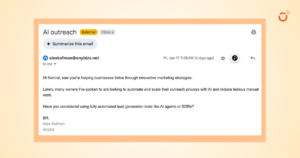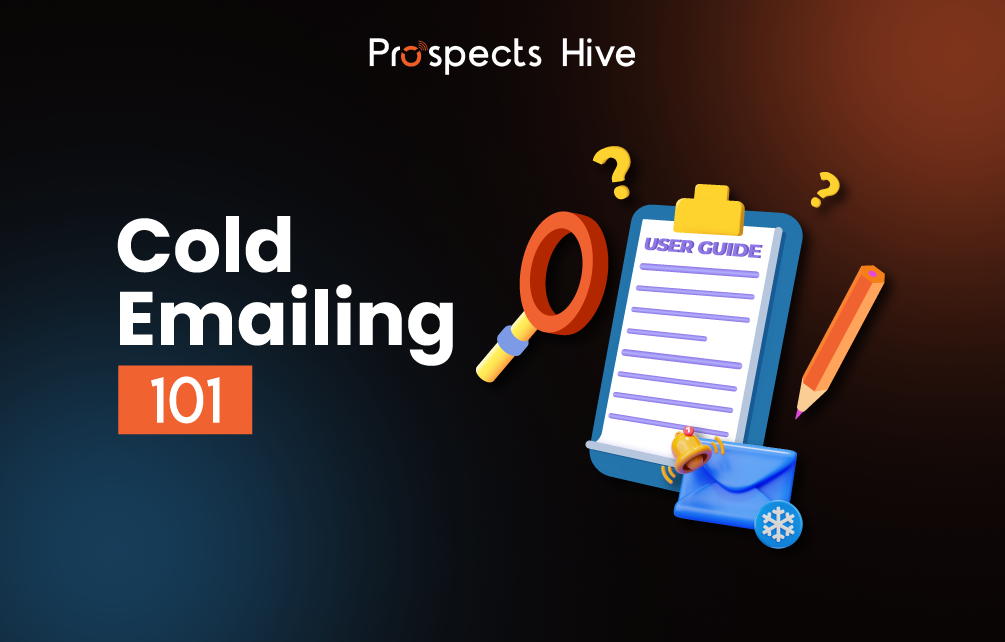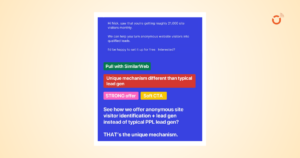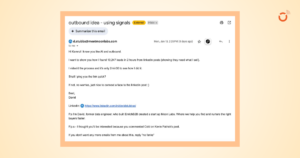Ever sent an email to someone you’ve never met, hoping they’d reply? That’s cold emailing. It’s a simple yet powerful way to reach potential clients and grow your business.
So, if you’re just hearing about it or want to learn how it works, this blog will show you how to master cold emailing step by step.
Step By Step Guide To Write a Cold Email
Sending a cold email is actually a great way to attract leads and grow your brand. Just follow these 7 simple steps to craft one that grabs attention and gets results.
Step 1: Define Your Goal Before Sending Emails
Before drafting your cold email, spend some time defining your goal. Are you looking to generate leads, promote your product or service, book more meetings, reach out to candidates, or build links? Once you know the answer, it is going to help you measure success and plan your next steps.
A clear goal also shapes your message so it includes the right details to spark a response from recipients. Plus, aligning your email with your goal increases your chances of success.
Step 2: Find and List Your Ideal Prospects
Once you’ve defined your goal, the next step is to research and list your ideal prospects. Even though it’s a cold email, you need to understand who you’re reaching out to and what matters to them.
Take time to look up details about their role, company, and interests to customize your message and make it more impactful.
To focus your research, consider these questions:
- Am I targeting too broad or too narrow an audience?
- Does my offering provide value to the recipient?
- Do I know what influences their decisions?
- Is their email inbox reachable, and are they likely to respond?
- Am I reaching out to the decision-makers in their organization?
If you don’t have a prospect list yet, agencies like Prospects Hive can help you identify and connect with the right audience.
Step 3: Create an Eye-Catching Subject Line
Your email subject line is the first thing your prospect notices, so it must capture their attention immediately. A strong subject line helps your email stand out from the crowd, while a generic one will likely go unnoticed.
The key is to keep it personalized, relevant, and compelling to your prospect’s needs or challenges.
Here’s an example:
- Bad subject line: Affordable Marketing Services for Your Business
- Good subject line: I noticed you follow [Trustworthy Expert]
The first example feels generic and impersonal. The second example is personalized and directly connects with the recipient. This makes it far more likely to catch their interest and get them to open your email.
Here are some tips for crafting subject lines that work:
- Keep it short, relevant, and attention-grabbing
- Keep your subject line short, stick to 3-6 words.
- Use simple, powerful language that resonates
- Ask questions related to their industry or challenges
- Offer insights or solutions specific to their needs
- Spark curiosity about your offerings
Step 4: Nail the Email Opening, Body, and Closing
After grabbing your prospect’s attention with a great subject line, it’s time to deliver a strong opening, body, and closing for your cold email.
Email Opening Paragraph
Your opening paragraph needs to hook the reader immediately. Start with something personalized, like referencing an achievement, a recent event, or a challenge they’re facing. This shows you’ve done your research and makes your email relevant to them.
Example: I saw that [Company Name] has expanded its services. Are you finding [specific challenge] more difficult to manage with this growth?
Email Body Content
Explain why you’re reaching out. Focus on their needs rather than talking about yourself. Mention a problem you’ve noticed or an opportunity they might be missing and tie it back to your expertise.
Example: We automate [specific task] with AI, so you save time and cut costs. Many in [industry] face [pain point], and we make it easier.
Email Ending Paragraph
Wrap up with a clear call-to-action that feels easy to respond to. Instead of pushing for a meeting, offer to share insights, answer a quick question, or provide useful details. If you haven’t included social proof in the body, this is a great place to add it.
Example: I can break this down for you in a quick summary. Want me to send it over?Just helped companies like yours improve [pain point]. Want me to share/solve them?
We recently helped [similar companies] solve [pain point] using [solution]. Want me to send over a few details?
When done right, this approach keeps your email focused, relevant, and action-oriented, exactly what your B2B audience needs.
Step 5: Add Social Proof to Build Credibility
Social proof can help prospects trust you. Since the recipient doesn’t know you, they’re more likely to believe your claims if backed by real results or recognitions.
For example, Prospects Hive helped Aerodei achieve an 80% positive conversion rate through a cold outreach strategy. Including similar success stories, awards, or partnerships in your email can work in your favor.
Here’s how to do that:
- Mention successful case studies or client results
- Highlight awards or recognitions
- Reference partnerships with notable brands
- Include a client testimonial or review
Or you can include any social validation.
Step 6: Use a Low-Commitment Call-to-Action
Think about it: your recipient reads your email and likes what they see but doesn’t know the next step. This is why you should add a low-commitment call-to-action (CTA).
Your CTA should be simple and easy to respond to, something they can do without much effort. For example:
Example:
“Would it be helpful if I sent over a quick summary?”
“Want me to share a few details?”
Be direct about what action you want them to take, but avoid being overly pushy or salesy. This way, your CTA can increase the chances of receiving a positive reply.
Step 7: Sign Off Professionally with Your Email Signature
You should end your email with a clear and professional signature. Add your name, company name, email address, job title, phone number, and any social media links. This way, the recipient can reach out to you.
You can also include your company’s logo or colors to reinforce your brand and leave a lasting impression. It also builds trust and increases the response rate.
Cold Emails Examples for B2B Leads
Here are some of the best cold email examples that work perfectly for generating B2B leads.
AI-Powered Prospecting

This cold email is well-structured and to the point. It starts with a personalized opener that highlights the recipient’s role and expertise in marketing. Instead of making a generic pitch, the sender identifies a common challenge.
He highlighted the difficulty of handling outreach manually and positioned AI as the solution.
Plus, the CTA is subtle and low-friction. It invites the recipient to consider AI tools rather than pushing a call or demo.
Smarter Lead Generation
This cold email does a great job of making the offer relevant and easy to say yes to. It starts by pointing out a specific insight about the recipient’s website traffic, instantly making it personal.
Then, it highlights a unique solution: turning anonymous visitors into leads. The CTA also keeps it effortless by suggesting a free setup so the recipient can take action easily.
Data-Driven Cold Outreach
This cold email is a great example of using data to grab attention. The sender jumps right in with a specific stat, like finding 10,247 leads in two hours. That instantly builds credibility and makes the recipient curious.
Instead of pitching, they offer a quick video link. It keeps the email casual and easy to engage with. The P.S. section adds a personal touch by referencing a LinkedIn comment.
All of this makes the email feel less like a sales pitch and more like a natural conversation.
What’s the Perfect Length for a Cold Email?
The perfect cold email is short and straight to the point. Aim for 2-5 sentences or around 50-120 words. This is enough to spark interest and start a conversation.
But before your email is even opened, the recipient only sees the subject line and a short preview in their inbox. That small snippet needs to grab their attention instantly.
Long emails with lengthy pitches often get ignored. Your prospects are busy and unlikely to read a detailed message from someone they don’t know.
So, keep it short and focus on their needs. A short, well-written email is far more likely to get a response.
What Is the Success Rate of Cold Emails?
The success rate of cold emails depends on several factors like industry, the quality of your email list, and how personalized your emails are. On average, cold email campaigns see a response rate of 1% to 5%.
If your emails are highly targeted and personalized, you’re more likely to hit the higher end of this range. The key is to write a message that feels personal and speaks to what matters most to the recipient.
5 Best Practices for Cold Email Success
Here are 5 golden rules of cold email. Just try to know them by heart.
Keep It Short
The number one rule of cold emailing is to keep it short. No more than 2-5 sentences. Long emails from strangers almost never get read, and even if they do, they rarely get a response.
People are busy and don’t have time to wade through lengthy pitches. Stick to the point, respect their time, and you’ll have a better chance of getting a reply.
Share Something Valuable They’ll Care About
Your cold email should always offer something valuable to the recipient. Make sure your introduction and pitch address their specific needs or challenges. If you’re offering a solution, make sure it solves a problem they actually have.
When prospects see the value in engaging with you, they’re more likely to respond.
Focus on Them, Not Yourself
Your cold email should always be about the recipient, not you. Prospects aren’t interested in your story. They care about how you can help solve their problems. So, focus on their needs, challenges, and goals, and tie everything back to how your solution benefits them.
Even when pitching, keep the focus on what they gain, not on your features or achievements.
Don’t Push the Hard Sell
A cold email is meant to start a conversation. Avoid sounding overly salesy in any part of your email. Instead, focus on building a connection with your prospect by addressing their needs or interests.
Keep it casual, relevant, and leave the hard sell for later stages of the relationship.
Always Follow Up to Stay on Their Radar
One email is rarely enough to get a reply. People are busy, forgetful, or sometimes even waiting to see if you’ll follow up. That’s why it’s so important to send a follow-up email.
Following up shows persistence and signals that you genuinely care about building a relationship. It helps you stay noticed and increases the chances of getting a response.
Wrap Up
Cold emails don’t have to be complicated or nerve-wracking. With the right approach, they can help you connect with your dream clients and open up exciting opportunities.
Still unsure how to start? Let Prospects Hive handle the heavy lifting and create cold emails that actually work. Reach out now and watch your outreach turn into results.
FAQs
Who uses cold emails?
Cold emails are widely used by marketers, with around 89% relying on them for lead generation. Businesses also use cold emails for market research.
How many cold emails per day?
If you’re just starting out, sending 10-20 cold emails per day is a good number. Before scaling up, it’s important to warm up your email account by gradually increasing the sending volume to avoid spam filters.
As you gain experience and use automation, you can gradually increase the daily count to scale your outreach.
What is a cold email signature?
A cold email signature is like a mini introduction at the end of your email. It includes your name, title, contact info, and sometimes a headshot, website link, or social media.






